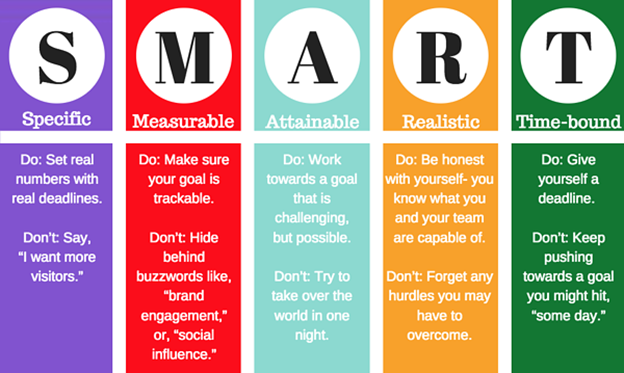
According to MindTools, the criteria of a SMART Goal is commonly attributed to Peter Drucker’s Management by Objectives concept. As you may have guessed, SMART is an acronym and, over the years, it has taken on many different meanings. Traditionally, a SMART Goal is something that is: Specific, Measurable, Attainable, Realistic and Time-bound.
Other common definitions are:
- S- simple, sensible, significant
- M- meaningful, motivating
- A- agreed
- R- reasonable, resourced, result-based
- T- time-based, time-limited, time/cost-limited, time-sensitive
Fun fact: A few authors have even gone as far as to add two more letters, making it SMARTER;
“E” being Evaluated, and “R” being Reviewed.
Setting SMART Goals means you can clarify your ideas and focus your efforts, which allows you to allocate your time in a way that promises the most return and the highest chance of achieving your goals. Why work towards a goal you cannot achieve or will get nothing out of?

Specific- To set a specific goal, you must first answer the six “W” questions:
- Who- Who is involved?
- What- What do you want to accomplish?
- Where- Identify a location.
- When- Create a timeframe.
- Which- Identify requirements and constraints.
- Why- Identify specific reasons, a purpose, or benefits of accomplishing the set goal.
Measurable- Establish the criteria for measuring your progress while you work towards your goal.
When you measure your progress:
You stay on track, in terms of dates.
You know when changes need to be made.
You see what efforts work best for you and your team.
Ask yourself questions like: How much? How many? And, how will I know when I achieve my goal?
Attainable- When you identify your goal and determine how you are going to achieve your goal; you see how attainable it is and how much effort it will require.
Look at the workload associated with this goal and be sure that it will not get in the way of other projects you are working on and that you will be able to dedicate enough time to achieving your goal.
Realistic- In order to be realistic, your goal should represent an objective toward which you are both willing and able to work towards. Just because you have set your goal high, it does not mean it is unrealistic. As long as you have the time and energy to put into it, you can achieve your goal.
Timely- As we have mentioned in a few of the SMART steps, time is important. No goal is achievable if you don’t have the time for it. All goals should be kept within a well detailed time frame.
SMART Goals provide the clarity and focus required to get the most out of your efforts. They also omit the possibility of overlooking major or minor details that will help or hinder your efforts towards achieving your goals. SMART Goals are a great way of getting yourself mentally prepared for what’s ahead. With more knowledge of what has to be done, you will be focused and aware of times when your attention should be aimed elsewhere.
One way you can measure this is to compare your current goal’s time frame to that of a past goal. If you were able to achieve like tasks within a similar time frame, you can feel confident in your ability to achieve your current SMART Goal.
